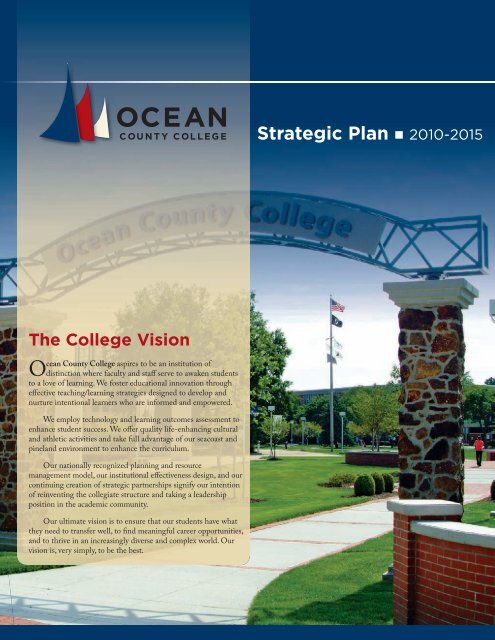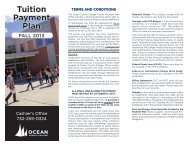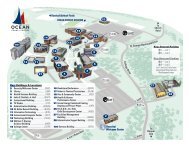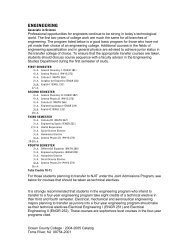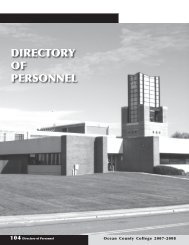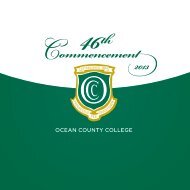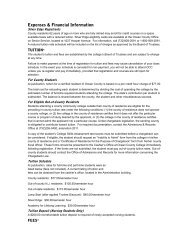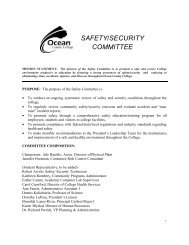Strategic Plan 2010-2015 - Ocean County College
Strategic Plan 2010-2015 - Ocean County College
Strategic Plan 2010-2015 - Ocean County College
Create successful ePaper yourself
Turn your PDF publications into a flip-book with our unique Google optimized e-Paper software.
<strong>Strategic</strong> <strong>Plan</strong> • <strong>2010</strong>-<strong>2015</strong><br />
The <strong>College</strong> Vision<br />
<strong>Ocean</strong> <strong>County</strong> <strong>College</strong> aspires to be an institution of<br />
distinction where faculty and staff serve to awaken students<br />
to a love of learning. We foster educational innovation through<br />
effective teaching/learning strategies designed to develop and<br />
nurture intentional learners who are informed and empowered.<br />
We employ technology and learning outcomes assessment to<br />
enhance student success. We offer quality life-enhancing cultural<br />
and athletic activities and take full advantage of our seacoast and<br />
pineland environment to enhance the curriculum.<br />
Our nationally recognized planning and resource<br />
management model, our institutional effectiveness design, and our<br />
continuing creation of strategic partnerships signify our intention<br />
of reinventing the collegiate structure and taking a leadership<br />
position in the academic community.<br />
Our ultimate vision is to ensure that our students have what<br />
they need to transfer well, to find meaningful career opportunities,<br />
and to thrive in an increasingly diverse and complex world. Our<br />
vision is, very simply, to be the best.
<strong>Ocean</strong> <strong>County</strong> Demographics<br />
As a county college, <strong>Ocean</strong> <strong>County</strong> <strong>College</strong>’s primary mission<br />
is to serve the citizens of <strong>Ocean</strong> <strong>County</strong>; therefore, the scope<br />
of its activities is dependent upon the nature of <strong>Ocean</strong> <strong>County</strong>,<br />
New Jersey. <strong>Ocean</strong> <strong>County</strong> is situated in the east central portion<br />
of the state and is the second largest county in land area (638<br />
square miles), ranked 6th of 21 counties in population according<br />
to the 2008 estimates conducted by the New Jersey Department<br />
of Labor and Workforce Development. The county has 45 miles of<br />
oceanfront and more than 150 miles of bay shores and estuaries.<br />
Toms River, the county seat and the location of <strong>Ocean</strong><br />
<strong>County</strong> <strong>College</strong>’s main campus, is located in the northern<br />
area of the county, approximately 70 miles from New<br />
York City, 60 miles from downtown Philadelphia, and 50<br />
miles north of Atlantic City.<br />
For the past five decades, <strong>Ocean</strong> has been the<br />
fastest growing county in New Jersey. During the 1960’s,<br />
<strong>Ocean</strong> <strong>County</strong>’s population grew by 93 percent, followed<br />
by a 66 percent increase in the 1970’s, 25 percent in<br />
the 1980’s, and 18 percent in the 1990’s. According<br />
to the most recent estimate, the county population<br />
is projected to increase from its 2002 estimate of<br />
536,769 to 617,600 in 2012 and 731,900 in 2025<br />
(New Jersey Department of Labor, 2008).<br />
Racially, the <strong>Ocean</strong> <strong>County</strong> population is primarily<br />
white. According to 2006 census data, 93.8 percent of the<br />
population was white. The primary minority groups are<br />
African American (3.4 percent) and persons of Hispanic origin<br />
(6.6 percent). It is anticipated that persons of Hispanic origin will<br />
have grown significantly by the next census, possibly to over 10<br />
percent of the county population.<br />
<strong>Ocean</strong> <strong>County</strong> is also home to a large number of retirees.<br />
During the last several decades, with the vast amount of<br />
inexpensive land available, developers created a number of large<br />
senior citizen communities, now numbering 92. According to the<br />
2006 estimates, 21 percent of the county residents were 65 years<br />
and over, far exceeding the 13 percent average for the state. The<br />
younger persons in the county, those under 18, comprised 22.6<br />
percent of the population in 2006 as compared with the 2000<br />
census of 23.3 percent.<br />
Per capita income varies significantly by county in New<br />
Jersey, from a low of $28,149 in Cumberland <strong>County</strong> to a high<br />
of $62,538 in Morris <strong>County</strong>. <strong>Ocean</strong> <strong>County</strong> had a per capita<br />
income of $34,509 for 2005, very close to the national average of<br />
$34,471. During the ten-year period from 1996 to 2005, <strong>Ocean</strong><br />
<strong>County</strong>’s per capita income rose by 39.2 percent as compared<br />
with a statewide increase of 42.6 percent. The resort and tourism<br />
industry has dominated the economic scene and, while this is still<br />
the most important industry in the county, the health care industry<br />
has been the fastest growing employment sector in the county.<br />
Employment projections in general, released by the NJ Department<br />
of Labor, show that <strong>Ocean</strong> <strong>County</strong> should continue to experience<br />
moderate employment growth into the future. Nonetheless,<br />
thousands of <strong>Ocean</strong> <strong>County</strong> residents continue to commute to job<br />
locations outside of <strong>Ocean</strong> <strong>County</strong> to nearby Monmouth <strong>County</strong><br />
or to northern New Jersey cities, New York City, and, to the south,<br />
Trenton, Philadelphia, and Atlantic City. Thus, county employment<br />
demographics have limited impact on the college curriculum.<br />
The nation’s recession has impacted upon the economy of<br />
<strong>Ocean</strong> <strong>County</strong> in terms of job growth but has had a<br />
lower impact on the increase in real estate ratables.<br />
According to the <strong>County</strong> Board of Taxation, the<br />
equalized assessed value of all <strong>Ocean</strong> <strong>County</strong> property<br />
was $74 billion in 2008, more than double that of<br />
2003.
The <strong>College</strong> and the Post-Secondary Educational Environment<br />
<strong>Ocean</strong> <strong>County</strong> <strong>College</strong> has relatively little direct competition<br />
with other postsecondary institutions within its geographic<br />
service area. Only one other college, Georgian Court University, is<br />
located in <strong>Ocean</strong> <strong>County</strong>. As a small, private liberal arts university,<br />
Georgian Court is considerably different from OCC in both<br />
programs and costs to the student. Georgian Court currently<br />
enrolls 1,955 undergraduates, with a tuition and fee charge of<br />
approximately $24,160 per year (24-36 credits). This is substantially<br />
higher than the current charge of $3,800 for a full-time OCC<br />
student per year (30 credits).<br />
Approximately 80 percent of the county high school graduates<br />
(class of 2007) go on to college the following year and OCC<br />
attracts 42 percent of those who do so, compared with 35 percent<br />
for the class of 2003.<br />
<strong>Ocean</strong> <strong>County</strong> <strong>College</strong> offers three degrees, the Associate in<br />
Arts (A.A.) degree, the Associate in Science (A.S.) degree, and the<br />
Associate in Applied Science (A.A.S.) degree. There are currently<br />
2 A.A. degree programs, 8 A.S. degree programs, 9 A.A.S. degree<br />
programs, 13 Certificate of Proficiency programs (30-36 credits),<br />
and 8 Certificate of Completion programs (12-24 credits). Within<br />
the degree programs, there are many options, transfer tracks, joint<br />
admission programs with the New Jersey colleges, and areas of<br />
emphasis within the Liberal Arts program.<br />
The students who attend <strong>Ocean</strong> <strong>County</strong> <strong>College</strong> in some<br />
ways typify the American community college student. They are a<br />
microcosm of the <strong>Ocean</strong> <strong>County</strong> population, young and old, men<br />
and women, and are representative racially. The <strong>College</strong> truly serves<br />
<strong>Ocean</strong> <strong>County</strong>; 96 percent of the fall 2008 student population<br />
resides in <strong>Ocean</strong> <strong>County</strong>. Only a very small proportion is from<br />
outside the county (2.3 percent), and an even smaller proportion<br />
comes from outside New Jersey (0.1 percent).<br />
The full-time students are younger than the part-time<br />
students, with an average age of 20.6 years as compared with 27.0<br />
years, respectively. The full-time students are primarily day students,<br />
and the part-time are primarily evening students, although many<br />
students take courses both in the day and evening and both full and<br />
part-time students take classes at the <strong>College</strong>’s off-campus sites.<br />
The substantial increase in student enrollment is beginning<br />
to place a strain on the availability of instructional space. The<br />
opening of the <strong>College</strong> Technology Building in spring 2003, the<br />
renovations in the Instructional Building in 2005, the addition to<br />
the Arts & Community Center, and a new instructional building,<br />
John C. Bartlett Jr. Hall, have helped by adding instructional space<br />
for the present and near future. For the spring 2008, the <strong>College</strong><br />
used 17 off campus sites in addition to its Manahawkin location,<br />
known as the Southern Education Center (SEC), and 12.7 percent<br />
of the total student credit hours are taken at these sites. The<br />
Facilities Master <strong>Plan</strong> anticipates an additional $50 million in new<br />
construction over the next ten years.<br />
The Board of Trustees of <strong>Ocean</strong> <strong>County</strong> <strong>College</strong> is the<br />
governing body of the <strong>College</strong> and derives its authority from<br />
New Jersey Statutes, Title 18A: Chapter 64A. The President of<br />
the <strong>College</strong> is the chief executive officer and reports directly to<br />
the Board of Trustees. There are seven major organizational units<br />
within the <strong>College</strong>: the President’s Office, the Executive Vice<br />
President’s Offices, Academic Affairs, Student Affairs, <strong>Plan</strong>ning<br />
and Administration, <strong>College</strong> Advancement, and Finance. There are<br />
seven Vice Presidents who report to the President. Also reporting<br />
directly to the President are the Assistant to the President for<br />
Institutional Quality, the Senior Assistant to the President, the<br />
Assistant to the President, the Executive Assistant to the President,<br />
and the members of the President’s immediate office staff.
Table Of Administrative Organization<br />
The roles and responsibilities of all <strong>College</strong> administrators<br />
are defined in the official position descriptions kept on<br />
file in the <strong>College</strong>’s Human Resources Office. The <strong>College</strong>’s<br />
organization, including administrative position titles and the<br />
names of individuals currently in the positions, is delineated in the<br />
organizational charts filed in the OCC Fact Book, available on the<br />
<strong>College</strong>’s web site. The upper-level administration chart is below:<br />
Bray Barnes<br />
Assistant to the<br />
President<br />
Connie Bello<br />
Executive Assistant to<br />
the President<br />
Board of<br />
Trustees<br />
Jon Larson, Ph. D.<br />
President<br />
Janet Hubbs<br />
Assistant to the President<br />
for Institutional Quality<br />
David Wolfe<br />
Senior Assistant to<br />
the President<br />
James McGinty<br />
Executive VP<br />
Richard Parrish<br />
VP <strong>Plan</strong>ning/Admin<br />
Sara Winchester<br />
VP Finance<br />
Donald Doran<br />
VP Student Affairs<br />
Tara Kelly<br />
VP <strong>College</strong><br />
Advancement<br />
(Unfilled)<br />
Executive VP,<br />
Academic Affairs<br />
Richard Strada<br />
Interim VP,<br />
Academic Affairs<br />
• <strong>Plan</strong>etarium<br />
• Kean at <strong>Ocean</strong><br />
• Special Projects<br />
• Labor Relations<br />
• Campus Security<br />
• Broadcast and<br />
Instructional<br />
Technologies<br />
<strong>Plan</strong>ning Assumptions<br />
<br />
• Institutional growth will continue to a maximum total of 20,000<br />
students on the main campus (developed to 30 percent of its land<br />
mass) by 2025, 8,000 students at the SEC by 2025, and an estimated<br />
4,000 at the 2 nd (WEC) extension site to be developed in 2020<br />
for a total campus unduplicated enrollment of 32,000. Distance<br />
Learning enrollments will increase exponentially as we explore new<br />
markets and create new partnerships.<br />
• The major mission of the <strong>College</strong> will continue to be to serve the<br />
transfer needs of the students using specialized career and jobs programs,<br />
work partnerships, certificate programs, and voc-tech alliances<br />
to serve the career needs of the county, as they present themselves.<br />
• The major academic partnerships the <strong>College</strong> pursues will be to<br />
make transfer baccalaureate and masters programs available on the<br />
<strong>College</strong>’s main campus or create alliances with schools that offer<br />
our graduates distinct academic advantages. We will continue to<br />
work to arrange articulation agreements that allow our students<br />
to transfer seamlessly to quality schools with financial assistance<br />
opportunities.<br />
•<br />
• Master <strong>Plan</strong>ning<br />
• Facilities<br />
• Maintenance<br />
• Barnegat Bay<br />
Partnership (BBP)<br />
• Bookstore<br />
• Accounting<br />
• Budget and Payroll<br />
• Financial Reporting<br />
• Human Resources<br />
• Financial Aid<br />
• IT<br />
• Arts & Community<br />
Center<br />
The major values of the <strong>College</strong> will continue to be academic quality,<br />
• Registration and Records<br />
• Athletics<br />
• Student Life<br />
• Recruitment and<br />
Admissions<br />
• EOF/Office of<br />
Multicultural Services<br />
• Advising<br />
• Health Services<br />
• Counseling<br />
• Retention/Persistence to<br />
graduation<br />
• <strong>College</strong> Foundation<br />
• <strong>College</strong> Relations<br />
• Grants<br />
• Alumni<br />
• Continuing Education<br />
• Academy for Lifelong<br />
Learning<br />
• Labor Relations<br />
• Library<br />
• Distance Learning<br />
• Special Projects<br />
variety and excellence of teaching/learning, and a national reputation<br />
for the academic preparedness and success of our graduates.<br />
• The educational delivery modes will continue to blend traditional<br />
classroom education with cutting edge technology in distance<br />
learning modes.<br />
• The <strong>College</strong> will continue to partner with the county and with business<br />
enterprises to develop resources that benefit the students and<br />
the citizens of <strong>Ocean</strong> <strong>County</strong>.<br />
• We will continue to affirm a culture of assessment leading to improved<br />
accountability, transparency, and overall institutional quality, utilizing<br />
data-based decision making practices whenever they are effective;<br />
• Increasing globalization will require further internationalization of<br />
the curriculum.<br />
• Social and cultural change in the larger society will continue to<br />
place demands on the <strong>College</strong> for organizational flexibility.<br />
• We assume continuing fiscal support from the state and county,<br />
but we recognize the need to expand the <strong>College</strong>’s capital position<br />
through effective and low-risk leveraging.<br />
• Academic Deans/Schools<br />
• Honors<br />
• Learning Assessment<br />
• Scheduling<br />
• Global Education<br />
• Instructional Support<br />
• Distance Extension<br />
Centers<br />
• Evening and Weekend<br />
<strong>College</strong>
Mission and Goals, <strong>2010</strong>-<strong>2015</strong><br />
It is the mission of <strong>Ocean</strong> <strong>County</strong> <strong>College</strong> to foster teaching/learning excellence and a caring, student-centered environment through its<br />
commitment to:<br />
Offer comprehensive educational programs that develop<br />
intentional learners of all ages and ensure the full assessment<br />
of student learning in these programs:<br />
Goal 1 Implement all appropriate recommendations for the<br />
advancement of Developmental Learning at the <strong>College</strong>;<br />
Goal 2 Implement all appropriate recommendations for the<br />
integrated academic engagement of first-year students;<br />
Goal 3 Advance student articulation needs;<br />
Goal 4 Develop programs that will serve needs generated by current<br />
economic conditions in collaboration with community, educational, and<br />
business partners;<br />
Goal 5 Develop a Teaching/Learning Institute on Campus for<br />
the improvement of teaching/learning as identified by learning<br />
assessment outcomes;<br />
Goal 6 Enhance our distance learning potential;<br />
Goal 7 Continue to recast the academic calendar for increased<br />
productivity.<br />
Provide broadly-based student support, starting from<br />
our initial contact with every individual, regardless of his<br />
or her unique needs:<br />
Goal 8 Implement appropriate recommendations for the integrated<br />
campus engagement of all students;<br />
Goal 9 Use results of the SENSE and CCSSE survey to assist with<br />
engagement assessment;<br />
Goal10 Continue to expand outreach to NJ STARS students and<br />
expand outreach to other targeted student demographic populations;<br />
Goal 11 Transition to the new one-stop, enrollment management<br />
facility;<br />
Goal 12 Join the effort for career services targeted at special<br />
populations;<br />
Goal 13 Expand and enhance the <strong>College</strong>’s athletic program.<br />
Measure employee attitudes toward the workplace and<br />
student attitudes toward the learning experience and<br />
make responsive adjustments in institutional strategies:<br />
Goal 14 Use PACE or other appropriate instrument to measure<br />
employee attitudes and develop recommendations for improvement<br />
based on the outcomes;<br />
Goal 15 Develop faculty subcommittees to create action plans based<br />
on <strong>2010</strong> CCSSE outcomes.<br />
Address our human resource needs by recruiting and<br />
hiring highly qualified people and continuing to develop<br />
the potential of each employee;<br />
Goal 19 Develop and implement as appropriate an employee succession<br />
plan for vacated positions;<br />
Goal 20 Address the need to employ more diverse faculty and staff<br />
and to create bonds in the Mexican-American community;<br />
Goal 21 Continue to use a mutual gains approach to collective bargaining<br />
and develop training programs to educate mid-management in<br />
the administration of labor contracts<br />
Goal 22 Implement <strong>College</strong>-wide staff development and training<br />
programs with particular emphasis on comprehensive new employee<br />
orientation and services for troubled employees;<br />
Goal 23 Undertake a comprehensive analysis of compensation,<br />
starting salary guidelines, and a classification system for non-represented<br />
employees;<br />
Goal 24 Complete a comprehensive review of all current performance<br />
evaluation systems and make replacements with interactive,<br />
meaningful systems where needed.<br />
Generate and manage fiscal resources to best serve<br />
strategic priorities:<br />
Goal 25 Continue to refine the long-term capital financial plan to<br />
support expansion and refurbishment of the campus; ensure capital and<br />
operating budgets are properly aligned and revenue stream estimates<br />
are realistic;<br />
Goal 26 Review outsourcing of services; assess efficiency and ROI;<br />
add or subtract as needed;<br />
Goal 27 Use this strategic plan as a major measure for new money<br />
requests to the <strong>Plan</strong>ning and Budgeting Council.<br />
Organize a leadership team committed to outreach,<br />
development, engagement, institutional effectiveness,<br />
and a fully realized implementation of the <strong>College</strong>’s<br />
vision:<br />
Goal 28 Provide periodic professional development for the leadership<br />
team to continue to function effectively as a team;<br />
Goal 29 Continue to meaningfully expand the use of an in-house<br />
electronic Board document management system for greater efficiency;<br />
Goal 30 Restructure leadership meeting schedules for maximized<br />
efficiency.<br />
Provide a well-designed campus and facilities with<br />
advanced technology:<br />
Goal 16 Continue to implement the Facilities Master <strong>Plan</strong><br />
based on enrollment growth and the development of a campus for<br />
Kean at <strong>Ocean</strong>;<br />
Goal 17 Explore innovative uses of technology in the classroom for<br />
both teaching/learning and classroom assessment techniques;<br />
Goal 18 Complete ongoing technological upgrades identified<br />
in the IT plan.<br />
Reach out to members of the <strong>Ocean</strong> <strong>County</strong> community<br />
and beyond in order to create meaningful, fulfilling, and<br />
mutually beneficial partnerships.<br />
Goal 31 Extend educational partnerships with Kean University, New<br />
Jersey City State University, Stockton <strong>College</strong>, and others,<br />
as appropriate;<br />
Goal 32 Create an institution-based initiative using effective<br />
technology to engage alumni as active participants in fundraising.
<strong>Ocean</strong> <strong>County</strong> <strong>College</strong> <strong>Strategic</strong> <strong>Plan</strong> • <strong>2010</strong>-<strong>2015</strong><br />
Office of the President<br />
<strong>College</strong> Drive • P.O. Box 2001 • Toms River, NJ 08754-2001<br />
phone 732.255.0330 • fax 732.255.0405 • web www.ocean.edu<br />
A public two-year community college sponsored by the <strong>County</strong> of <strong>Ocean</strong> and the State of New Jersey


